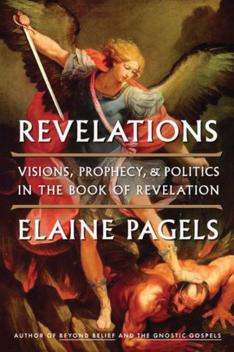

The Book of Revelation is one of the most popular books in history. Its vivid rendering of the last judgment as a battle between the forces of God and Satan has inspired writers as diverse as John Milton, William Blake, and James Baldwin. In her new book, Revelations: Visions, Prophecy, and Politics in the Book of Revelation (Viking), religion professor Elaine Pagels explains the historical roots of this apocalyptic text and how it became the last book in the New Testament.
The author of Revelation, Pagels writes, “wants to speak to the urgent question that people have asked throughout human history ... How long will evil prevail, and when will justice be done?”
Pagels is an expert in early Christianity. She received wide acclaim for her book The Gnostic Gospels, which introduced the Gospel of Thomas and other early Christian texts to the general reader. In her new book, Pagels writes that many revelation texts were composed in the early years of Christianity. Yet like the Gnostic Gospels — ancient wisdom teachings that were considered heterodox by some early Christian leaders — they were not included in the New Testament canon, often for political reasons.
The author of the Book of Revelation was John of Patmos, a prophet who belonged to the second generation of Jesus’ disciples. After Jewish rebels were crushed by Roman forces in Judea, John fled to the island of Patmos. Inspired by visions and still reeling from the Roman destruction of the Jewish Temple, John began writing. Pagels emphasizes that the Book of Revelation is “wartime literature,” and part of its popularity stems from its dreamlike depiction of the forces of evil. Readers at the time, she writes, would have cast their Roman oppressors in the role of Satan and his minions.
“John probably used such cryptic images because open hostility to Rome could be dangerous; he may have feared reprisal,” Pagels writes.
An influential early Christian leader, Irenaeus, found John’s account compelling, and argued for its inclusion in the New Testament. He saw John’s images of the “beast” as a dramatic metaphor for those who persecuted the early Christians. Irenaeus also saw “the beast” represented in “false” Christian believers he called heretics.
John’s account was one of many revelation texts. Yet while John’s Revelation relayed a startling vision, other revelation texts recounted more modest encounters with revealed truth. These “secret” writings often were mystical in nature, and include spiritual “dialogues” between Jesus and his disciples. Unlike John’s Revelation, they did not pit good against evil in stark terms, and presented the search for truth as a process, not a matter of doctrinal assent.
“Different as they are, they all seem to talk about a universal vision of humanity,” Pagels said. “It’s not just the saved and the damned, the good and the evil. But it’s about all humans and how they can find the divine.”
Over time, the cryptic imagery in John’s Book of Revelation allowed various groups to appropriate the text for their own purposes. Following the emergence of Christianity as the official religion of the Roman Empire in the fourth century, the book was used as a tool against Christians who were considered unorthodox. That trend, sadly, continued for centuries.
Pagels hopes her book will bring attention to other revelation texts, which offer a different message. “These sources invite us to recognize our own truths, to find our own voice,” she writes, to seek revelation not only in historical texts, but in today’s world, too.

